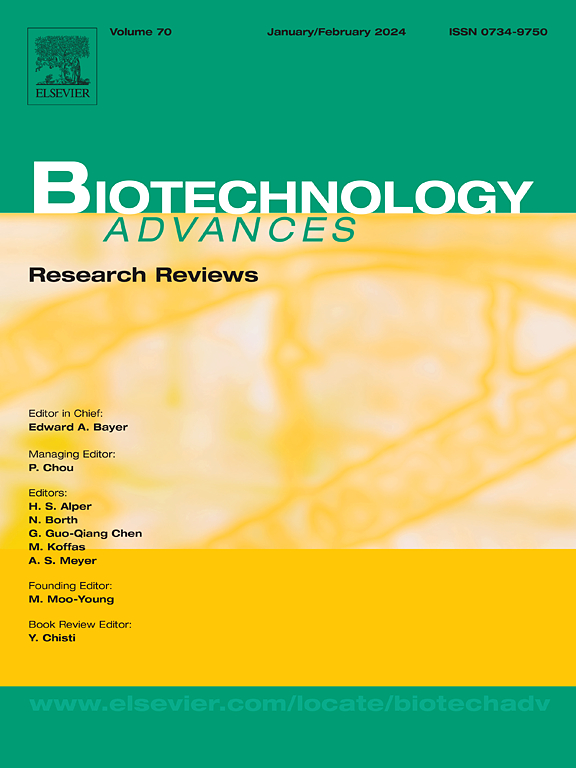Metal-organic frameworks (MOFs) for enhanced biological CO2 fixation: Advances and applications in enzyme catalysis and living cell applications
IF 12.5
1区 工程技术
Q1 BIOTECHNOLOGY & APPLIED MICROBIOLOGY
引用次数: 0
Abstract
The conversion of CO2 into fuels and chemicals via biological routes has gained significant attention due to its high efficiency and mild reaction conditions. However, biological CO2 fixation faces several challenges, including the low solubility of CO2, the poor stability of free enzymes and cells under harsh conditions, and the high cost of cofactors such as NAD(P)H. Metal-organic frameworks (MOFs), with their unique characteristics including high surface area, tunable pore structure, and ease for functionalization, have emerged as promising candidates to address these limitations. When integrated into biological CO2 fixation systems, MOFs serve multiple functions: as CO2 capture agents, enzyme immobilization carriers, cellular protective layers, and scaffolds for photosensitizers and electron mediators for efficient cofactor regeneration. Despite extensive reviews on MOF-based chemical CO2 conversion, their applications in biological CO2 fixation have not been reviewed. This review first introduces the characteristics and synthesis methods of MOFs, followed by an in-depth exploration of MOFs applications in biological CO2 fixation systems. For enzyme-based systems, this review explores strategies for enzyme immobilization and synergistic integration of other key catalytic components within MOFs, and discusses the multifaceted roles of MOFs in these hybrid systems, and their applications in enzymatic catalysis, photoenzymatic catalysis, and enzymatic electrosynthesis. Regarding living-cell based systems, MOF-cell integration through physical mixing or self-assembly is explored, with analysis of the mechanisms by which MOFs facilitate living cell-based CO2 fixation. The final section addresses current challenges in the field, including issues related to scale-up and environmental impacts, while providing perspectives on future development directions.
金属有机框架(MOFs)用于增强生物CO2固定:酶催化和活细胞应用的进展和应用
通过生物途径将二氧化碳转化为燃料和化学品因其效率高和反应条件温和而受到广泛关注。然而,生物CO2固定面临着一些挑战,包括CO2的溶解度低,游离酶和细胞在恶劣条件下的稳定性差,以及NAD(P)H等辅助因子的高成本。金属有机框架(mof)具有高表面积、可调孔隙结构和易于功能化等独特特性,有望解决这些局限性。当整合到生物CO2固定系统中时,mof具有多种功能:作为CO2捕获剂,酶固定载体,细胞保护层,光敏剂支架和有效辅助因子再生的电子介质。尽管基于mof的化学CO2转化已经得到了广泛的研究,但它们在生物CO2固定中的应用尚未得到综述。本文首先介绍了MOFs的特点和合成方法,然后深入探讨了MOFs在生物CO2固定体系中的应用。对于基于酶的系统,本文探讨了MOFs中酶固定和其他关键催化组分协同整合的策略,并讨论了MOFs在这些混合系统中的多方面作用,以及它们在酶催化、光酶催化和酶电合成中的应用。对于基于活细胞的系统,MOF-cell通过物理混合或自组装进行整合,并分析了mof促进基于活细胞的CO2固定的机制。最后一部分阐述了该领域当前面临的挑战,包括与规模扩大和环境影响有关的问题,同时对未来的发展方向提出了展望。
本文章由计算机程序翻译,如有差异,请以英文原文为准。
求助全文
约1分钟内获得全文
求助全文
来源期刊

Biotechnology advances
工程技术-生物工程与应用微生物
CiteScore
25.50
自引率
2.50%
发文量
167
审稿时长
37 days
期刊介绍:
Biotechnology Advances is a comprehensive review journal that covers all aspects of the multidisciplinary field of biotechnology. The journal focuses on biotechnology principles and their applications in various industries, agriculture, medicine, environmental concerns, and regulatory issues. It publishes authoritative articles that highlight current developments and future trends in the field of biotechnology. The journal invites submissions of manuscripts that are relevant and appropriate. It targets a wide audience, including scientists, engineers, students, instructors, researchers, practitioners, managers, governments, and other stakeholders in the field. Additionally, special issues are published based on selected presentations from recent relevant conferences in collaboration with the organizations hosting those conferences.
 求助内容:
求助内容: 应助结果提醒方式:
应助结果提醒方式:


